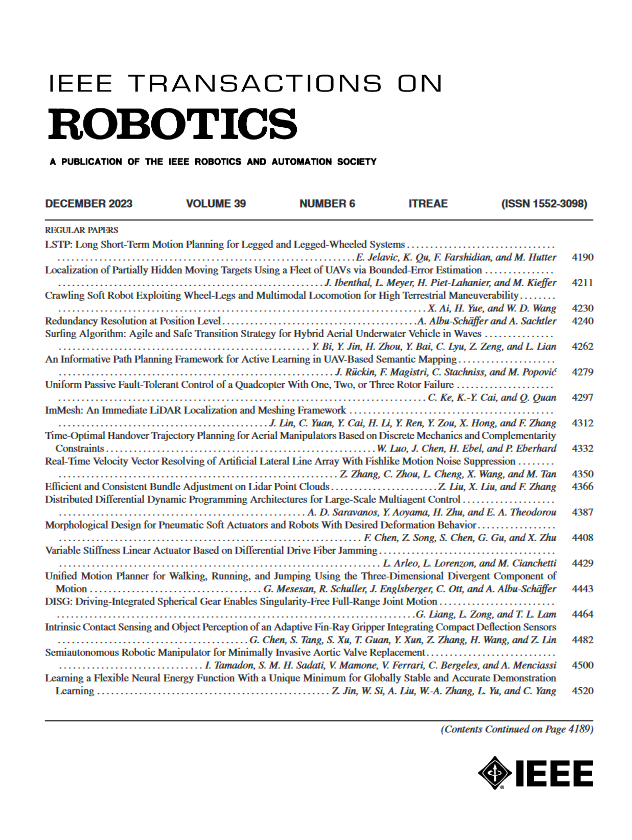利用凸集图规划非凸代价函数的最优无碰撞轨迹
IF 10.5
1区 计算机科学
Q1 ROBOTICS
引用次数: 0
摘要
最近发展的凸集图(GCS)运动规划方法为利用凸优化计算最短距离无碰撞路径提供了一个有效的框架。这种新的运动规划器明显比流行的基于采样的运动规划器计算效率更高,但它不支持非凸代价函数。本文提出了一种新的运动规划算法——具有一般代价的凸集图(GCSGC)来解决这一问题。利用多层ReLU神经网络精确逼近给定的非凸代价函数,并利用神经网络的隐层将构型空间分解为一组线性代价区域。这些线性代价区域与一组无冲突区域相交,得到的无冲突线性代价区域相交,形成运动规划器底层图结构的顶点和边缘。边缘代价在每个无碰撞线性代价区域内都有一个闭合解,但它是非凸的,因此应用McCormick松弛来凸化边缘代价。最后,提出了一种图预处理技术,计算出具有代表性的图结构,作为底层GCS边缘成本的启发式算法,然后通过去除循环和高成本路径来简化底层图结构,从而显著提高规划器的效率和生成轨迹的质量。首先在二维构型空间中对所提出的运动规划器进行了验证,比较了经过预处理和未经过预处理的不同大小的神经网络,比较了GCSGC与最短距离轨迹的最优轨迹,并比较了GCSGC与gcs -顺序线性规划(SLP)的比较。通过比较最先进的多查询(PRM*, GCS-SLP)和单查询(TrajOpt, BIT*, AIT*, RRT*)规划器,GCSGC规划器在复杂的7-D配置空间中进一步得到验证。结果表明,所提出的运动规划器在计算效率、轨迹成本和内存占用方面具有很强的竞争力。两个物理实验进一步验证了所提出的运动规划器在实际运动规划应用中的有效性。本文章由计算机程序翻译,如有差异,请以英文原文为准。
Plan Optimal Collision-Free Trajectories With Nonconvex Cost Functions Using Graphs of Convex Sets
The recently developed approach to motion planning in graphs of convex sets (GCS) provides an efficient framework for computing shortest-distance collision-free paths using convex optimization. This new motion planner is notably more computationally efficient than popular sampling-based motion planners, but it does not support nonconvex cost functions. This article develops a novel motion planning algorithm, graph of convex sets with general costs (GCSGC), to solve this problem. A given nonconvex cost function is accurately approximated by a multiple-layer ReLU neural network and the configuration space is decomposed into a set of linear-cost regions using the hidden layers of the neural network. These linear-cost regions are intersected with a set of collision-free regions, and the resulting collision-free linear-cost regions are intersected to form the vertices and edges of the motion planner’s underlying graph structure. The edge costs have a closed-form solution within each collision-free linear-cost region, but it is nonconvex, so the McCormick relaxation is applied to convexify the edge costs. Finally, a graph preprocessing technique is developed to compute a representative graph structure that acts as a heuristic for the edge costs of the underlying GCS and then simplify the underlying graph structure by removing cycles and high-cost paths, which can significantly improve the efficiency of the planner and quality of the produced trajectories. The proposed motion planner is first validated in a 2-D configuration space with comparisons between different sized neural networks with and without preprocessing, comparisons between optimal trajectories from GCSGC with shortest-distance trajectories, and comparisons between GCSGC and GCS-Sequential linear programming (SLP). The GCSGC planner is further validated in a complex 7-D configuration space by comparing to state-of-the-art multiquery (PRM*, GCS-SLP) and single-query (TrajOpt, BIT*, AIT*, RRT*) planners. The results show that the proposed motion planner is very competitive in terms of computational efficiency, trajectory cost, and memory footprint. Two physical experiments further validate the effectiveness of the proposed motion planner in real-world motion planning applications.
求助全文
通过发布文献求助,成功后即可免费获取论文全文。
去求助
来源期刊

IEEE Transactions on Robotics
工程技术-机器人学
CiteScore
14.90
自引率
5.10%
发文量
259
审稿时长
6.0 months
期刊介绍:
The IEEE Transactions on Robotics (T-RO) is dedicated to publishing fundamental papers covering all facets of robotics, drawing on interdisciplinary approaches from computer science, control systems, electrical engineering, mathematics, mechanical engineering, and beyond. From industrial applications to service and personal assistants, surgical operations to space, underwater, and remote exploration, robots and intelligent machines play pivotal roles across various domains, including entertainment, safety, search and rescue, military applications, agriculture, and intelligent vehicles.
Special emphasis is placed on intelligent machines and systems designed for unstructured environments, where a significant portion of the environment remains unknown and beyond direct sensing or control.
 求助内容:
求助内容: 应助结果提醒方式:
应助结果提醒方式:


